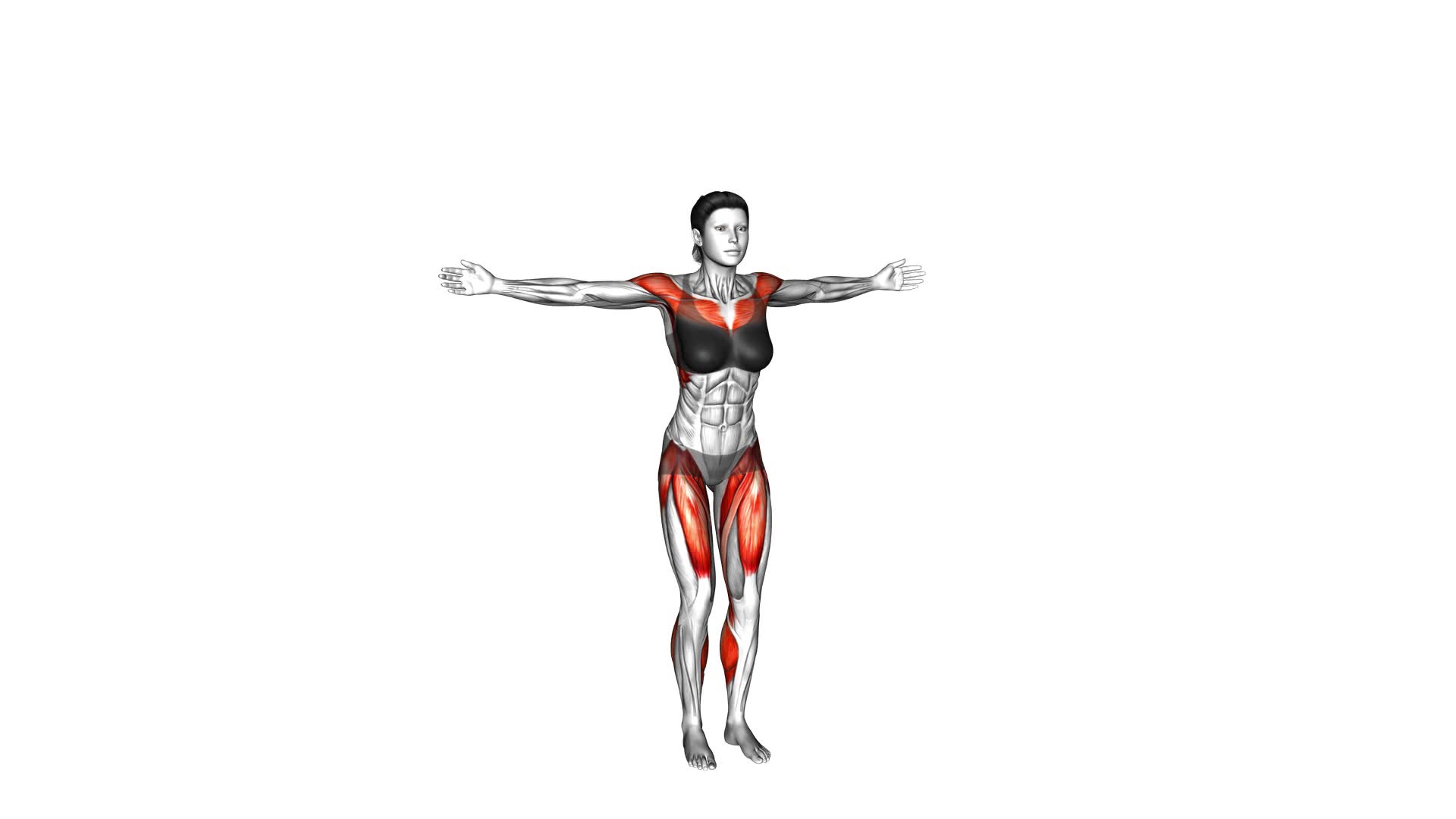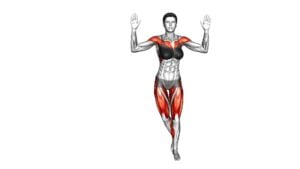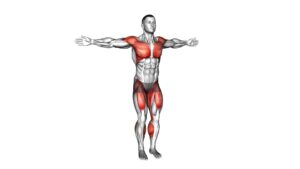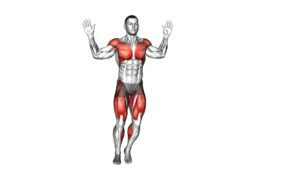Side Step Fly (female) – Video Exercise Guide & Tips

Are you looking for a new exercise to add to your routine?
Watch This Exercise Video
The Side Step Fly (female) is a fantastic choice that targets multiple muscle groups. In this video exercise guide, we'll show you the proper form and technique, as well as modifications for all fitness levels.
We'll also share common mistakes to avoid and tips for incorporating this exercise into your workout routine.
Get ready to take your fitness to the next level with the Side Step Fly (female)!
Key Takeaways
- The Side Step Fly exercise targets multiple muscle groups including shoulders, chest, and glutes.
- It improves upper body strength and stability.
- It enhances performance in other exercises and daily activities.
- Modifications and progressions can be made to cater to all fitness levels and physical limitations.
Benefits of the Side Step Fly (female) Exercise
To maximize the effectiveness of your workouts, incorporating the Side Step Fly (female) exercise can provide numerous benefits for your overall fitness and strength. The Side Step Fly is a versatile exercise that targets multiple muscle groups, including the shoulders, chest, and glutes.
One of the main benefits of this exercise is that it helps to improve upper body strength and stability. By performing the Side Step Fly, you can strengthen the muscles in your shoulders and chest, which can enhance your performance in other exercises and daily activities.
There are also various variations of the Side Step Fly that you can incorporate into your workout routine. For example, you can use dumbbells or resistance bands to add extra resistance and challenge to the exercise. Another variation is to perform the exercise on an unstable surface, such as a Bosu ball, which can engage your core muscles even more.
To execute the Side Step Fly effectively, it's important to maintain proper form and technique. Start by standing with your feet shoulder-width apart and holding dumbbells or resistance bands in each hand. Take a step to the side while simultaneously raising your arms out to the sides until they're parallel to the floor. Keep your core engaged and your back straight throughout the movement. Return to the starting position and repeat on the other side.
Incorporating the Side Step Fly into your workouts can help to improve your overall fitness and strength. By varying the exercise and following proper execution tips, you can maximize the benefits and see progress in your upper body strength and stability.
Proper Form and Technique for the Side Step Fly (female)
To execute the Side Step Fly (female) exercise with proper form and technique, you need to focus on maintaining a stable position and engaging the targeted muscles. Here are some tips to help you perform the exercise correctly:
- Start by standing with your feet hip-width apart and your arms extended out to the sides, holding a dumbbell in each hand.
- Take a step to the side with your right foot, keeping your left foot planted firmly on the ground.
- As you step to the side, bend your right knee and lower your body into a side lunge position. Keep your back straight and your chest lifted.
- As you lower into the side lunge, simultaneously bring your arms together in front of you, crossing them at chest level. This movement engages your chest and shoulder muscles.
- Push off with your right foot and return to the starting position, extending your arms back out to the sides.
- Repeat the exercise on the opposite side, stepping to the left and crossing your arms in front of your chest.
- Continue alternating sides for the desired number of repetitions.
Modifications and Progressions for All Fitness Levels
Now let's talk about how you can modify the Side Step Fly exercise to accommodate different fitness levels. Whether you're just starting out or looking to challenge yourself, there are options for everyone.
We'll explore ways to adapt the exercise for different abilities and provide variations that will push advanced fitness levels to new heights.
Adapting for Different Abilities
With modifications and progressions, you can adapt the Side Step Fly exercise to accommodate all fitness levels. Here are some ways to modify and progress the exercise for different abilities:
- Adapting for disabilities:
- For individuals with limited mobility or balance issues, perform the exercise while seated on a stability ball or chair.
- Use resistance bands instead of dumbbells to reduce joint stress and provide a gentler workout.
- Modifying for injuries:
- If you have a knee injury, perform the exercise with a smaller range of motion or substitute the side step with a step tap.
- If you have shoulder pain, decrease the weight or use resistance bands instead of dumbbells.
- Progressions for advanced fitness levels:
- Increase the weight or resistance to challenge your muscles further.
- Add a plyometric element by performing a jump during the side step.
Remember to always listen to your body and consult with a healthcare professional before attempting any modifications or progressions.
Challenging Advanced Fitness Levels
As you progress to more advanced fitness levels, there are several modifications and progressions you can incorporate into the Side Step Fly exercise to continue challenging your muscles.
To increase the intensity of this exercise, you can start by using heavier dumbbells or resistance bands. This will add more resistance and force your muscles to work harder.
Another advanced modification is to perform the exercise on an unstable surface, such as a balance board or BOSU ball. This will engage your core muscles even more as they work to stabilize your body.
Additionally, you can increase the speed of your movements or add a jump at the end of each rep to further challenge your cardiovascular system.
Remember to always listen to your body and progress at a pace that feels comfortable for you.
Common Mistakes to Avoid During the Side Step Fly (Female)
To perform the Side Step Fly (Female) correctly, make sure you avoid these common mistakes:
- Poor form: One of the most common mistakes is using improper form during the exercise. Make sure you maintain a strong, upright posture throughout the movement, keeping your core engaged and shoulders relaxed.
- Neglecting modifications: Many people fail to modify the exercise according to their fitness level. If you're a beginner or have any physical limitations, start with a lighter resistance band and focus on mastering the technique before progressing to more challenging variations.
- Lack of progression: On the other hand, some individuals neglect to progress the exercise as they become stronger. To continue benefiting from the Side Step Fly (Female), gradually increase the resistance or try more advanced variations, such as using a heavier band or performing the exercise on an unstable surface.
- Rushing through the movement: Lastly, avoid rushing through the Side Step Fly (Female). Take your time to fully extend your arms out to the sides, feeling the resistance in your shoulders and upper back. Slow and controlled movements will ensure maximum engagement of the targeted muscles.
By avoiding these common mistakes, you can perform the Side Step Fly (Female) effectively and safely.
Now, let's move on to the next section for tips on how to incorporate this exercise into your workout routine.
Tips for Incorporating the Side Step Fly (Female) Into Your Workout Routine
To effectively incorporate the Side Step Fly into your workout routine, it's crucial to focus on proper form techniques. This includes maintaining a stable core, engaging your glutes and thighs, and keeping a controlled movement throughout.
By performing this exercise correctly, you can reap the benefits of improved hip strength, stability, and overall lower body conditioning.
Additionally, for those looking to add more challenge, variations such as holding dumbbells or incorporating resistance bands can provide an extra level of difficulty.
Proper Form Techniques
Incorporate proper form techniques for the Side Step Fly (female) into your workout routine to maximize effectiveness and prevent injury. Here are some important tips to help you achieve the best results:
- Maintain proper posture: Keep your back straight and core engaged throughout the exercise. This will help target your muscles and prevent strain on your lower back.
- Control your movements: Avoid using momentum to swing your arms. Instead, focus on controlled movements to fully engage your muscles and get the most out of each repetition.
- Watch your foot placement: Make sure your feet are shoulder-width apart and firmly planted on the ground. This will provide stability and help you maintain balance during the exercise.
- Use appropriate resistance: Start with lighter weights and gradually increase the resistance as you become more comfortable with the exercise. This will help prevent injury and allow you to progress safely.
Benefits of Side Step Fly
As you continue with the Side Step Fly (female), you can experience a range of benefits by incorporating this exercise into your workout routine. The Side Step Fly not only targets your upper body, but also engages your core and lower body muscles. By performing lateral movements, you can improve your overall balance and stability.
Additionally, this exercise helps to strengthen your shoulders, chest, and back muscles. The Side Step Fly can also be modified to suit your fitness level. For beginners, you can start with lighter weights and gradually increase the resistance as you progress.
Advanced individuals can add variations such as using resistance bands or performing the exercise on an unstable surface. These modifications will intensify the workout and provide additional challenges to further enhance your strength and coordination.
Now, let's explore some variations for added challenge in the next section.
Variations for Added Challenge
To add more challenge to your Side Step Fly (female) exercise, you can try incorporating variations that target different muscle groups and increase the intensity of your workout. Here are some advanced modifications to consider:
- Weighted Side Step Fly: Hold dumbbells or resistance bands in your hands while performing the exercise to add resistance and increase the workload on your upper body.
- Plyometric Side Step Fly: Instead of stepping one foot at a time, explode off the ground and switch feet in mid-air, adding a jump to each side step. This will engage your leg muscles and elevate your heart rate.
- Single-leg Side Step Fly: Perform the exercise while balancing on one leg. This variation will challenge your stability and core strength while still targeting your upper body.
- Elevated Side Step Fly: Place your foot on an elevated surface such as a step or bench while performing the exercise. This will increase the range of motion and engage your glutes and hamstrings.
Incorporating these variations into your Side Step Fly routine will provide added intensity and help you progress in your fitness journey.
Sample Side Step Fly (female) Workout Plan
Follow this sample Side Step Fly (female) workout plan to strengthen your muscles and improve your overall fitness. The Side Step Fly exercise is a great way to target your glutes, hips, and thighs while also engaging your core and upper body. If you're a beginner, it's important to start with modifications that suit your fitness level.
Begin your workout with a 5-minute warm-up to get your muscles ready for exercise. This can include light cardio exercises like jogging in place or jumping jacks.
Once you're warmed up, perform 2 sets of 10 reps of the Side Step Fly exercise. Start by standing with your feet shoulder-width apart and a resistance band around your ankles. Take a step to the side with your right foot, keeping tension on the band. As you step, raise your arms out to the side, squeezing your shoulder blades together. Return to the starting position and repeat on the other side.
To modify this exercise, you can use a lighter resistance band or perform the exercise without any resistance. As you progress, you can increase the number of sets or reps. Remember to listen to your body and take breaks when needed.
With consistency and proper form, you'll soon see the benefits of the Side Step Fly exercise in your strength and overall fitness.
Frequently Asked Questions
How Many Calories Does the Side Step Fly (Female) Exercise Burn?
The side step fly (female) exercise can be a great addition to your cardio routine. Not only does it help you burn calories, but it also targets your lower body muscles, including the glutes, thighs, and calves.
By incorporating this exercise into your workout, you can increase your overall calorie burn and improve your cardiovascular endurance.
Additionally, there are various variations of the side step fly (female) exercise that you can try to add intensity and variety to your routine.
Can the Side Step Fly (Female) Exercise Help Tone the Inner Thighs?
The Side Step Fly exercise is a great way to tone your inner thighs. By stepping sideways and using resistance bands, this exercise targets the muscles in your inner thighs, helping to strengthen and tone them.
If you're looking for alternatives to the Side Step Fly, you can try exercises like squats, lunges, or leg lifts, which also work the inner thigh muscles.
Remember to consult with a fitness professional to ensure proper form and technique.
Is the Side Step Fly (Female) Exercise Suitable for Beginners?
Yes, the side step fly exercise is suitable for beginners.
It's a great way to work your inner thighs and tone them.
This exercise can be done without resistance bands, making it accessible for everyone.
The side step fly exercise burns calories and helps to strengthen and tone your legs.
For optimal results, it should be performed regularly as part of your workout routine.
Check out the Video Exercise Guide & Tips {560112} for more information and variations of this exercise.
Can the Side Step Fly (Female) Exercise Be Done Without Resistance Bands?
Yes, the side step fly (female) exercise can be done without resistance bands. However, using resistance bands can offer additional benefits such as increased muscle activation and strength.
If you don't have access to resistance bands, there are alternative exercises you can try to target similar muscles.
Remember to consult with a fitness professional to ensure you're using proper form and technique to avoid any injuries.
How Often Should the Side Step Fly (Female) Exercise Be Performed for Optimal Results?
To get the most out of the side step fly exercise, you need to perform it regularly. The frequency of the exercise depends on your fitness level and goals.
Generally, it's recommended to do the side step fly exercise 2-3 times a week for optimal results. You can also vary the intensity or add variations to challenge different muscles and keep your workouts engaging.
Remember to listen to your body and consult a professional if needed.
Conclusion
In conclusion, the side step fly (female) is a beneficial exercise that targets the upper body and helps improve strength and stability.
By following proper form and technique, avoiding common mistakes, and incorporating modifications and progressions, individuals of all fitness levels can safely perform this exercise.
Adding the side step fly (female) to your workout routine can enhance overall fitness and contribute to a well-rounded exercise program.

Author
Years ago, the spark of my life’s passion ignited in my mind the moment I stepped into the local gym for the first time. The inaugural bead of perspiration, the initial endeavor, the very first surge of endorphins, and a sense of pride that washed over me post-workout marked the beginning of my deep-seated interest in strength sports, fitness, and sports nutrition. This very curiosity blossomed rapidly into a profound fascination, propelling me to earn a Master’s degree in Physical Education from the Academy of Physical Education in Krakow, followed by a Sports Manager diploma from the Jagiellonian University. My journey of growth led me to gain more specialized qualifications, such as being a certified personal trainer with a focus on sports dietetics, a lifeguard, and an instructor for wellness and corrective gymnastics. Theoretical knowledge paired seamlessly with practical experience, reinforcing my belief that the transformation of individuals under my guidance was also a reflection of my personal growth. This belief holds true even today. Each day, I strive to push the boundaries and explore new realms. These realms gently elevate me to greater heights. The unique combination of passion for my field and the continuous quest for growth fuels my drive to break new ground.







